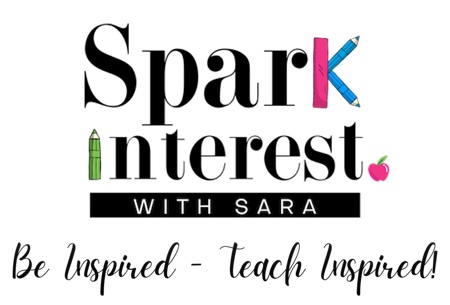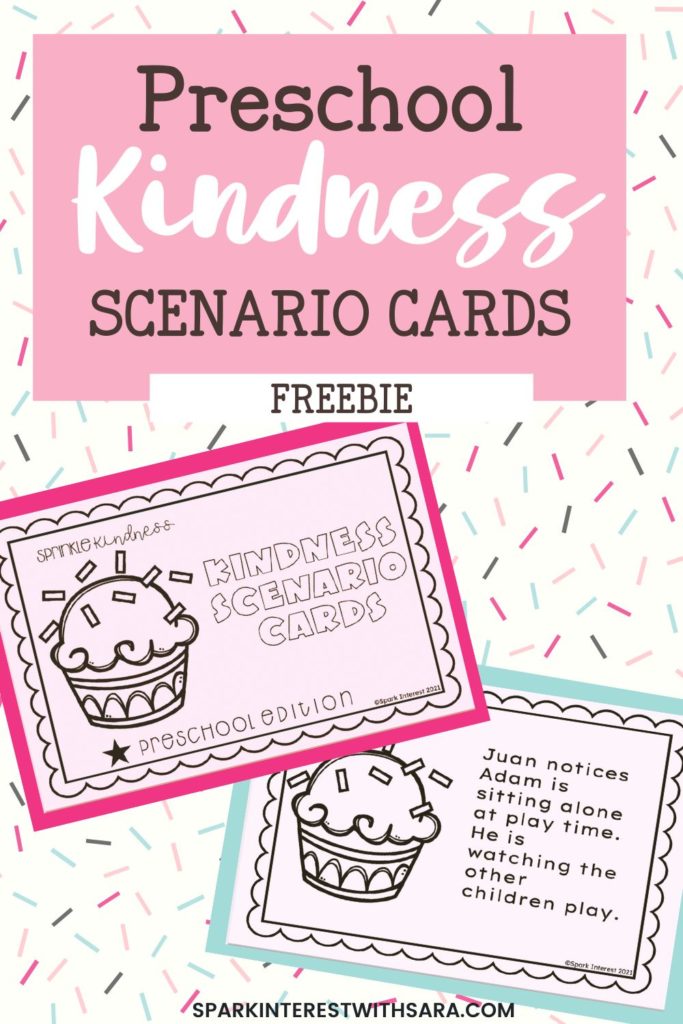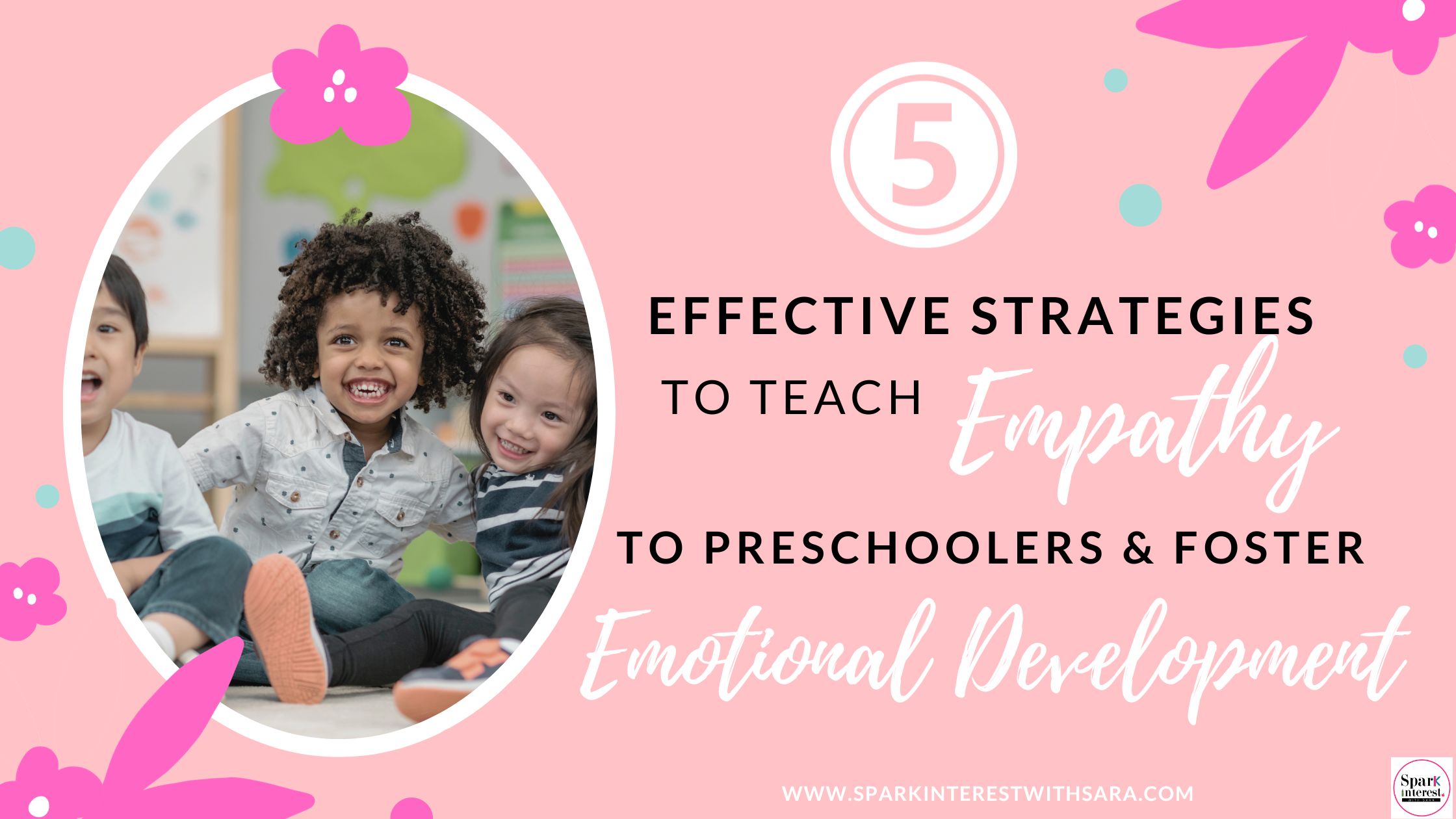
Teaching empathy to preschoolers is a crucial step in their social and emotional development. It lays the foundation for healthy relationships and compassionate behavior throughout their lives. But how do we effectively teach empathy to preschoolers?
In this blog post, we will be looking at practical strategies and activities to help preschoolers develop empathy. From modeling empathetic behavior to using storytelling and role-playing, there are various techniques that can engage and educate our young learners.
Before we jump into all the nitty gritty details of teaching empathy to your young learners, I wanted to make sure you got your hands on a free resource I created which will help your students see that they can sprinkle kindness into any situation! Click on the image below to download it now.
What is empathy and why is it important?
Empathy is the ability to understand and respond to the feelings of others. It involves recognizing emotions, showing kindness, and taking the perspective of someone else. By teaching empathy early on, we help children navigate conflicts, build strong friendships, and create a more inclusive society.
Research has shown that children who demonstrate empathy are more likely to exhibit prosocial behavior, such as sharing, cooperating, and helping others. They also tend to have better conflict resolution skills and are less likely to engage in aggressive or disruptive behavior.
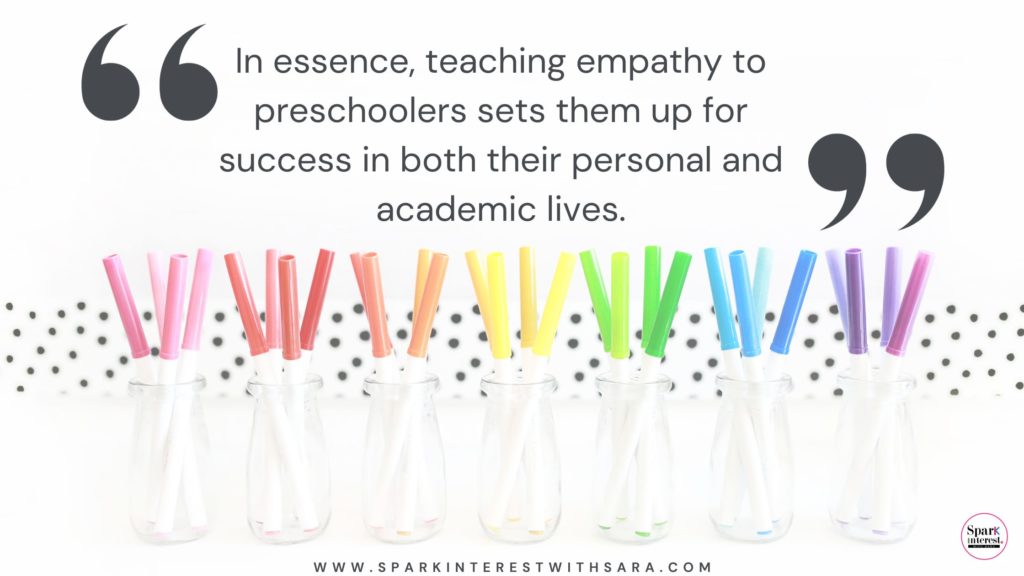
The benefits of teaching empathy at a young age
Empathy is the ability to understand and share the feelings of others. It involves recognizing and acknowledging different emotions, and responding in a caring and supportive manner. It goes beyond sympathy, which is simply feeling sorry for someone, as it requires putting oneself in another person’s shoes and experiencing their emotions.
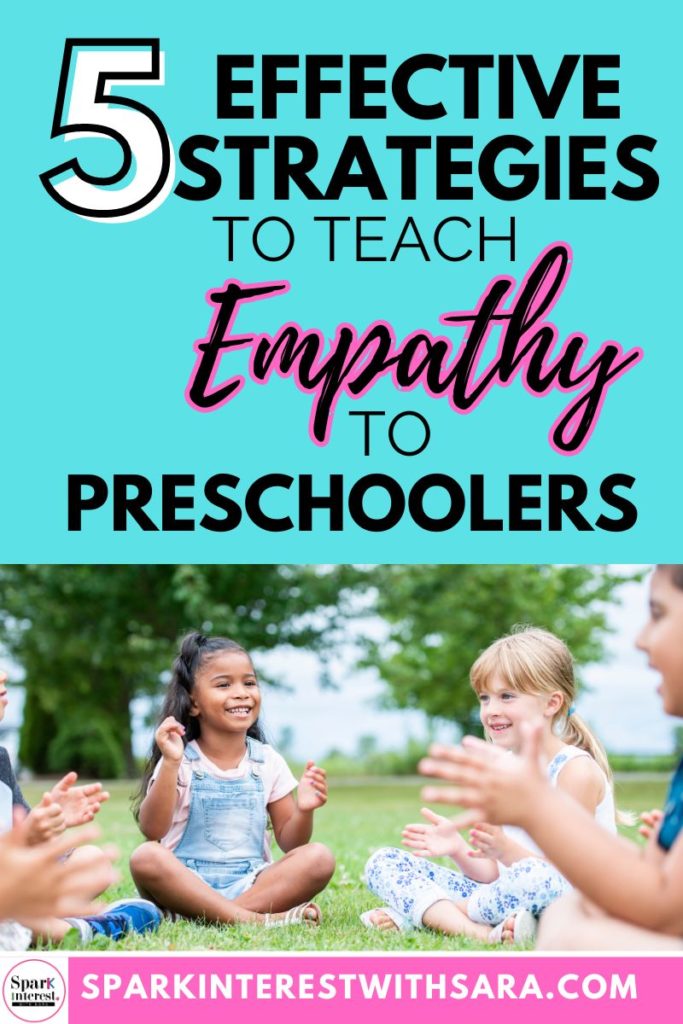
Teaching empathy to preschoolers has numerous benefits that extend far beyond their early years. By nurturing this essential skill, we lay the foundation for a lifetime of compassionate behavior and positive social interactions.
Some of the key benefits of teaching empathy at a young age include:
1. Improved social skills: Empathy helps preschoolers understand social cues and emotions, enabling them to navigate social situations more effectively. It promotes active listening, cooperation, and conflict resolution skills.
2. Enhanced emotional intelligence: By recognizing and responding to the emotions of others, preschoolers develop emotional intelligence. This allows them to regulate their own emotions and empathize with others, leading to better self-awareness and self-management.
3. Positive relationships: Empathy forms the basis of healthy relationships. By teaching preschoolers to understand and respond to the feelings of others, we help them build strong and supportive friendships. This fosters a sense of belonging and reduces the likelihood of social isolation.
4. Increased kindness and compassion: Empathy cultivates kindness and compassion in preschoolers. When they understand the impact of their actions on others, they are more likely to engage in prosocial behavior, such as sharing, helping, and showing empathy towards their peers.
5 Effective Strategies to Teach Empathy to Preschoolers:
- Developing empathy through play and activities
One effective way to teach empathy to preschoolers is through play and interactive activities. Play is a natural and enjoyable way for children to explore emotions, understand perspectives, and practice empathy. Here are some ideas for incorporating empathy into playtime:
1. Role-playing: Encourage preschoolers to take on different roles and act out different scenarios that involve understanding and responding to the emotions of others. This could include friendship scenarios, fairness scenarios or empathy scenarios.
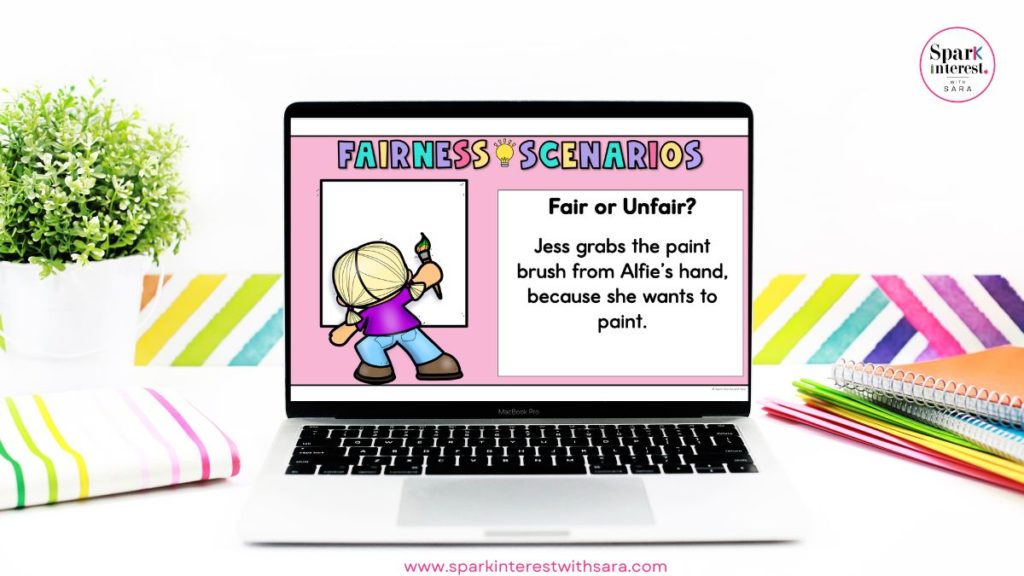
2. Empathy games: Play games that promote empathy, such as “Emotion Charades” or “Feelings Match.” These games help preschoolers recognize and express different emotions, while also encouraging them to consider how others might feel in various situations. Being able to identify and label their own feelings and emotions is vital in developing empathy.
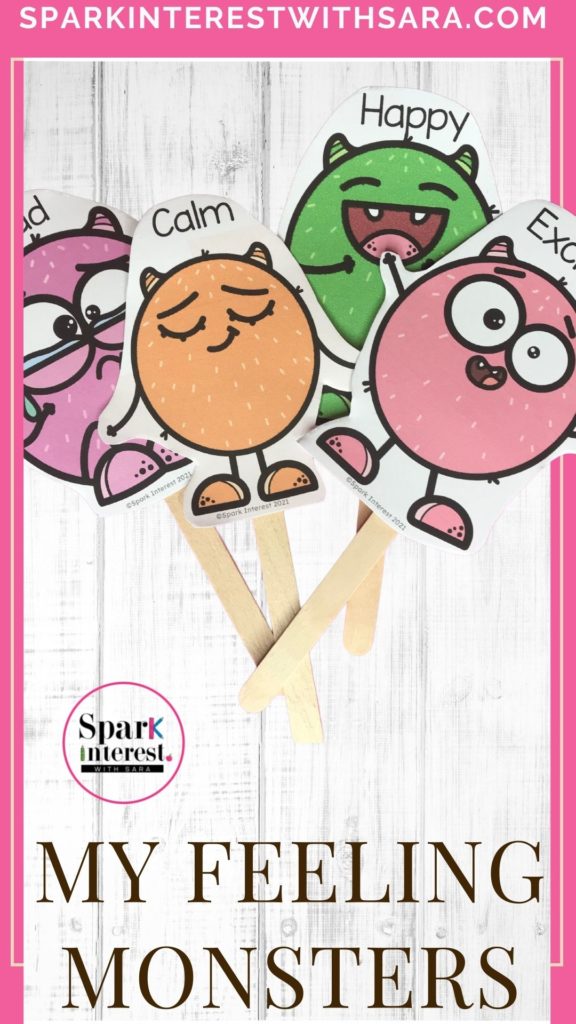
3. Puppet shows: Use puppets to create stories and situations that highlight empathy. Preschoolers can take turns manipulating the puppets and expressing different emotions. This allows them to explore empathy from different perspectives and practice responding with kindness and understanding.
By incorporating empathy into play and activities, preschoolers can develop a deeper understanding of emotions and learn how to respond empathetically in real-life situations.
- Teaching empathy through storytelling and books
Storytelling and books offer powerful opportunities to teach empathy to preschoolers. Through engaging narratives and relatable characters, children can learn about different emotions, perspectives, and experiences. Here are some ways to incorporate empathy into storytelling:
1. Choose books with diverse characters: Select books that feature characters from different backgrounds, cultures, and abilities. This exposes preschoolers to a variety of experiences and helps them develop empathy towards people who may be different from themselves.
2. Discuss emotions and character motivations: While reading a story, pause and ask preschoolers how they think a character might be feeling and why. Encourage them to reflect on their own emotions and relate them to the emotions portrayed in the story. This helps develop empathy by connecting personal experiences with those of others.
3. Encourage empathy-related discussions: After reading a book, engage preschoolers in discussions about the characters’ emotions and actions. Ask open-ended questions that encourage them to think about how they would feel or act in similar situations. This helps them develop empathy by considering different perspectives and responses.
By using storytelling and books as tools for teaching empathy, preschoolers can develop a greater understanding of emotions, build empathy towards others, and learn how to respond with kindness and understanding. If you’d like a list of awesome picture books that support your students’ understanding of empathy check out this blog post.
- Modeling empathy as a caregiver or teacher
One of the most powerful ways to teach empathy to preschoolers is through modeling. Children learn by observing and imitating the behavior of those around them. Here are some ways to model empathy in your interactions with preschoolers:
1. Be attentive and present: Show preschoolers that you value their emotions and experiences by being fully present and attentive during interactions. Maintain eye contact, actively listen, and respond empathetically to their feelings and needs.
2. Validate emotions: Help preschoolers understand and process their emotions by acknowledging and validating their feelings. Use phrases like “I can see that you’re feeling sad” or “It’s okay to be angry, but let’s find a way to express it without hurting others.” This teaches them that their emotions are valid and that it’s important to consider the feelings of others.
3. Use positive reinforcement: Recognize and praise preschoolers when they demonstrate empathy towards others. For example, you can say, “I noticed how kind you were when you shared your toys with your friend. That shows empathy and caring.” This reinforces empathetic behavior and encourages them to continue practicing it.
4. Practice problem-solving: When conflicts arise, guide preschoolers in finding empathetic solutions. Encourage them to consider the feelings of others and come up with ideas that promote understanding and compromise. This helps them develop conflict resolution skills and reinforces the importance of empathy in resolving conflicts.
By modeling empathy in your interactions with preschoolers, you provide them with real-life examples and experiences that help them develop empathy and compassionate behavior.
- Creating a nurturing and inclusive classroom environment
The classroom environment plays a crucial role in fostering empathy among preschoolers. By creating a nurturing and inclusive space, we provide opportunities for children to practice and develop their empathetic skills. Here are some strategies to create such an environment:
1. Establish clear expectations: Set clear expectations for behavior that promote empathy and kindness. Discuss and reinforce these expectations regularly, emphasizing the importance of treating others with respect and understanding.
2. Foster a sense of belonging: Create a classroom culture where all children feel valued and included. Encourage cooperative activities, group projects, and opportunities for peer interaction. This helps preschoolers develop empathy by learning to appreciate and respect the perspectives and contributions of others.
3. Encourage empathy-related language: Use words and phrases that promote empathy in your interactions with preschoolers. Encourage them to use language that expresses understanding and kindness. For example, instead of saying, “You’re wrong,” encourage them to say, “I understand your perspective, but I see it differently.”
4. Teach conflict resolution skills: Provide preschoolers with the tools and strategies they need to resolve conflicts in empathetic ways. Teach them active listening, problem-solving, identifying size of a problem and asking for help. This empowers them to navigate conflicts with empathy and understanding.
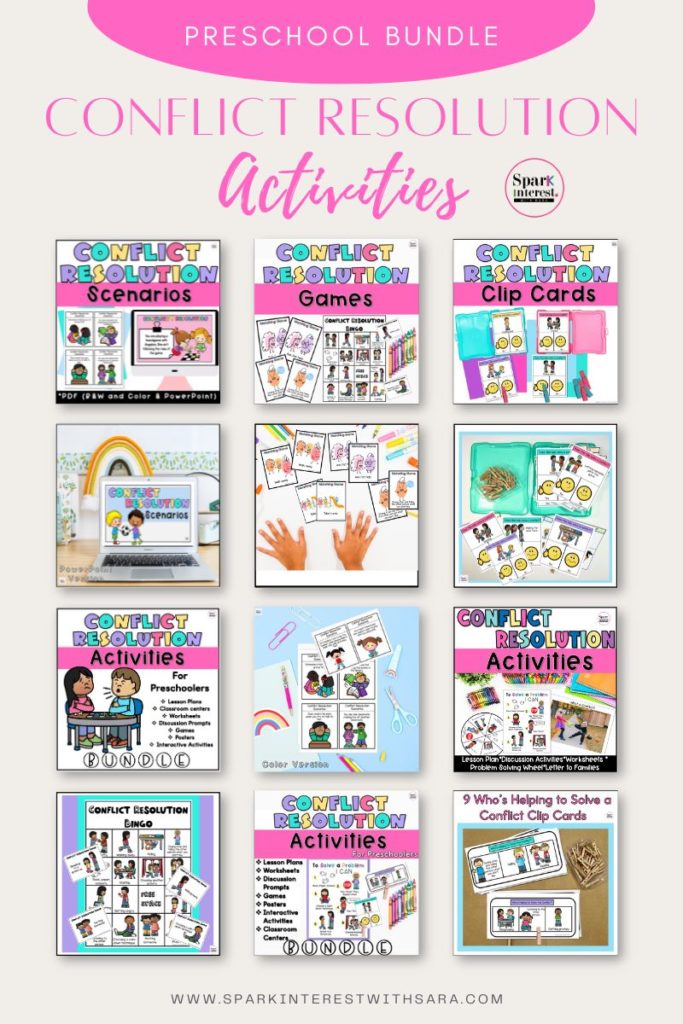
By creating a nurturing and inclusive classroom environment, we provide preschoolers with the support and structure they need to develop empathy and thrive socially.
- Collaborating with families to reinforce empathy at home
Teaching empathy should not be limited to the classroom. Collaborating with parents is essential to reinforce empathetic behavior at home. Here are some ways to involve parents in teaching empathy:
1. Parent workshops: Organize workshops or information sessions for parents to educate them about the importance of empathy and provide strategies for nurturing it at home. Share resources such as books, articles, and activities that parents can use to promote empathy with their preschoolers.
2. Home-school partnerships: Establish open lines of communication with parents and encourage them to share their observations and concerns regarding their child’s development of empathy. Collaborate on strategies and approaches that can be used both at home and in the classroom.
3. Empathy-themed activities: Suggest empathy-themed activities that parents can engage in with their preschoolers, such as volunteering together, discussing emotions, or engaging in acts of kindness. This allows parents to reinforce empathy in their daily interactions with their children.
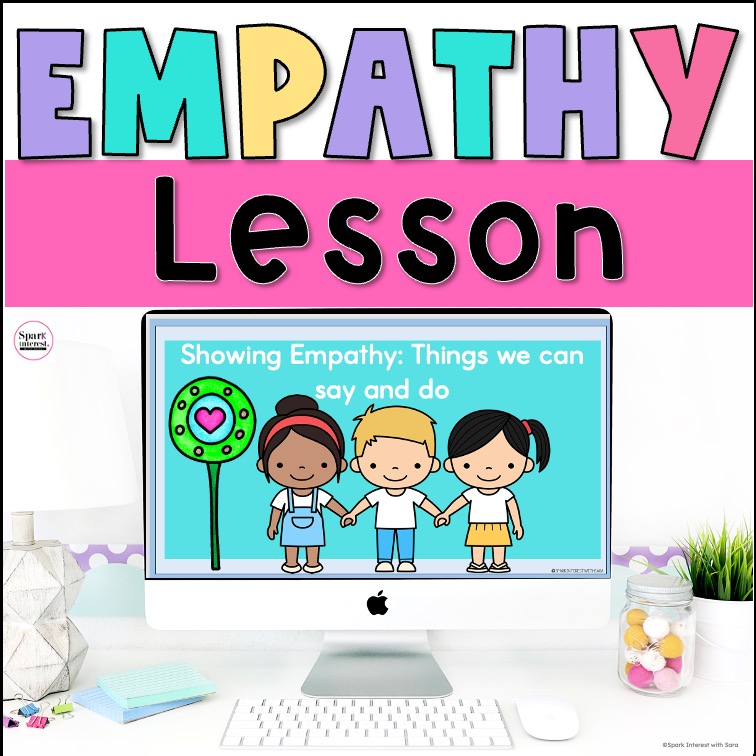
By involving parents in the teaching of empathy, we create a more holistic approach that reinforces empathetic behavior both at home and in the classroom.
Conclusion: Let’s Teach Empathy to Preschoolers Today!
Empathy is important because it allows children to develop meaningful connections with others. It helps them develop a sense of belonging and fosters a supportive and inclusive community. Helping our young students understand and respond to the emotions of others will help them significantly as they navigate the world of conflicts, building friendships and contributing to their social environment!
Want more teaching empathy tips & tricks? Check these blog posts out:
Teaching Empathy in Preschool: Why Should I Care?
Let's Connect:

Sara
